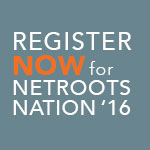After a great run, the Winning the Internet blog has been retired. However, you can still keep in touch with New Media Mentors here.
 As we get ready for Netroots Nation 2014, we’re taking a closer look at some of the convention’s most exciting training sessions. We’re interviewing the trainers and taking you inside some of online activism’s most popular and elusive topics.
As we get ready for Netroots Nation 2014, we’re taking a closer look at some of the convention’s most exciting training sessions. We’re interviewing the trainers and taking you inside some of online activism’s most popular and elusive topics.
Today we’re interviewing Elena Perez, who’ll be leading Click here! How to write advocacy emails that work.
NN14 Training Session
Click here! How to write advocacy emails that work
Tired of writing emails with good open rates but low clickthrough and action rates? The problem may lie in your presentation. Learn how to structure and write your emails to help create reader engagement and organizational identification. We’ll cover building a theory of change, creating a grabby lede, making a compelling ask and creating a long-term organizational narrative. This training is ideal for anyone starting an organizational email stream or looking to improve email performance.
Interview
Q: Tell us about yourself and your experience writing mass emails.
A: Well, I’ve written emails everywhere from MoveOn.org to the California National Organization for Women to a tiny animal rights organization in New Mexico, and now I’m working with the SEIU-UHW. Because I’ve had such a variety of audiences to write for, I’m able to recognize and speak to the email needs and challenges of a wide range of organizations, whether you’re national, statewide, or local, and multi-issue or single-issue.
Q: In your opinion, what is the most common mistake that organizations make when writing emails?
A: I think the biggest mistake–and it’s one I see frequently–is not having a clear and compelling reason why you’re writing in the first place. If you can’t tell me why that email matters in one sentence, you probably shouldn’t be sending it.
Q: What are the two most important things to keep in mind when drafting an email?
A: Number one top of the list is this: Your readers are busy people, so make your email worth their time. There are a lot of pieces that go into that, but that’s what it boils down to.
After that, I’d say you need to meet your readers where they are, not assume that they’re where you are. That applies both in the sense of actual use of language and terminology, and the larger question of how you present an issue in the first place.
Q: Why should folks attend your session at Netroots Nation, and how can they connect with you?
A: This session won’t just be a PowerPoint presentation or a lecture, it’s a run-through on the basics and then a full-on dive into a hands-on Q&A and editing session where you’ll be able to directly see how to apply the principles. So you won’t walk out wondering, “But how do I really use this?” because you’ll know.
In fact, I’m actively soliciting session attendees to give me emails they want help with, to use in the training. That could mean sending me a sample of a previous email or a draft for one they have coming up, and if they follow me on Twitter (@ElenaNPerez) I’ll be tweeting out links to email writing resources in the lead up to the training, too.
To attend this training, or one of the 39 others at Netroots Nation 2014 in Detroit, register now.




Trackbacks/Pingbacks
[…] By Melissa Foley […]
[…] Getting Congress to Read Your Emails: Quick & Practical Pointers. C.f Email Design Best Practices and Click here! How to write advocacy emails that work. […]